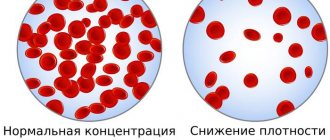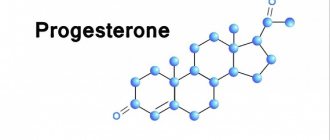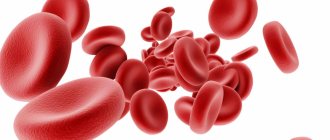Hematocrit - what is it, what does it depend on
Hematocrit analysis provides data on the ratio of the volume of red blood cells to the total volume of blood; sometimes this indicator refers to the ratio of the volume of all formed elements to the total volume. There is no particular difference between the interpretations; 99% of the blood cell volume is made up of red cells. More often, hematocrit is recorded as a percentage of the total volume, less often as a ratio of cell volume to total blood volume.
This indicator is determined as part of a general blood test complex. It is classified as secondary and is calculated based on data on the number of red blood cells. Occasionally, direct measurement of hematocrit is performed by centrifuging the sample. This procedure allows you to separate plasma from formed elements and directly measure this indicator.
What affects hematocrit
There are many reasons explaining the fluctuations in this indicator, but all of them can be divided into two parts. This is an insufficient intake of micronutrients into the blood and/or their incorrect absorption, as well as diseases: chronic, systemic, autoimmune. Both reasons are closely related, since impaired metabolism of useful substances leads to a number of pathologies, and such preconditions are observed not only in the aspect of the hematopoietic system. However, it is in the formation of blood quality that micronutrients play an extremely important role.
Diseases, consequences of treatment
Any pathology always has a reason, and most often it is an imbalance of micronutrients, metabolic disorders, sometimes aggravated by lifestyle. Less commonly – autoimmune reactions of the body and the administration of drugs prescribed in the course of treatment of various diseases.
The following diseases and methods of combating them are a priority for diagnosis if low hematocrit values .
— anemia – various types of this pathology occur against the background of a lack of a group of basic micronutrients or when their absorption is impaired;
- acute bleeding - both in injuries and in chronic forms;
- cirrhosis of the liver - the organ is the main “filter” of the blood, participates in the process of erythropoiesis, supplying the red bone marrow with the necessary iron for the formation of red blood cells;
- kidney pathologies - this organ produces the hormone erythropoietin (hemopoietin), also necessary for the formation of fully functional red blood cells;
- oncological diseases - affect the functioning of all body systems, one way or another, affecting the production of red blood cells;
- hydration - excess fluid in the body, also after drips with saline or other intravenous fluids.
Elevated hematocrit is characterized by another group of diseases and conditions:
-COPD – chronic obstructive pulmonary disease. Lack of oxygen and hypoxia directly affect the quality of gas exchange, leading to a weakening of antioxidant protection. Oxidative stress, in turn, reduces the efficiency of the transport function of red blood cells and changes the structural and functional state of red blood cells as a whole.
- heart failure - especially with a tendency to aggregation (sticking together) of red blood cells. Blood microcirculation is disrupted, swelling appears, and the quality of metabolic processes is lost;
- polycythemia - excess production of red blood cells;
- kidney disease, tumors - increased production of the hormone erythropoietin occurs;
-dehydration is dehydration, a reversible condition that can occur with any poisoning, injury, or during diabetes therapy.
It is worth noting that fluctuations in hematocrit do not always indicate pathology or impaired metabolism of vitamins and nutrients. HCT test results are closely related to fluid imbalance in the body, and these conditions are inevitable during pregnancy. During the gestation period, the value often drops below normal and this phenomenon is normal, since the expectant mother’s body is often swollen. When there is excess fluid in the tissues, the liquid portion of the blood also increases. Against this background, the hct volume looks reduced. There is no reason for concern, since the absolute values of red blood cells and in particular hemoglobin remain unchanged.
On the contrary, an increase in hct is often observed in smokers, as in the case of COPD, this is due to a lack of oxygen supply to cells.
Micronutrient deficiency
Iron and vitamins B9 and B12 play a critical role in maintaining a healthy hematocrit level.
— iron is an element involved in the formation of hemoglobin, which is part of the red blood cell and carries oxygen along with the blood, an essential element of most reactions in the body, a priority important part of cellular nutrition;
-vitamin B6 is water soluble, like the entire B group, that is, it does not accumulate in the body. Together with iron, it is required for the synthesis of hemoglobin;
— vitamin B9 or folic acid is an extremely important element for growth, development, in particular, of blood cells, the full functioning of the circulatory system, and immunity;
— vitamin B12 – a group of cobalamins. Actively affects hematopoietic processes; a lack of this vitamin can provoke megaloblastic anemia.
Both vitamins B9 and B12 are required for normal DNA synthesis and cell division. All four micronutrients (B8, B9, B12 and iron) are key, essential elements for meeting the needs of the hematopoietic system. Other compounds are also important, but their role can be considered secondary, auxiliary. These are copper, calcium, tocopherol (vitamin E), Omega-3 and Omega-6 fatty acids.
Indications and preparation for analysis
Indications for hematocrit analysis are symptoms indicating the development of anemia or other diseases of the blood or hematopoietic system. These include:
- Pale or jaundiced skin
- Enlarged spleen, liver
- Changes in the size of lymph nodes
- Digestive disorders
- Skin and hair problems (rashes, ulcers on mucous membranes, hair loss or brittleness)
In addition to identifying anemia, the analysis allows us to identify other diseases, for example, polycythemia (a chronic disease in which the bone marrow produces an excess amount of red blood cells) of various origins. This study is also used when it is necessary to assess the need for blood transfusion and calculate the required volume of transfusion.
No special preparation is required for the hematocrit test. It is necessary to follow the standard rules for conducting a general blood test:
- Blood is drawn early in the morning.
- You should not eat food 6-10 hours before the test.
- Avoid alcohol 2-3 days before the procedure.
Patients who smoke are advised to abstain from smoking for at least 2-3 hours before blood collection. If these recommendations are not followed, the analysis may give unreliable results. This is due to the fact that the composition of the blood is subject to strong fluctuations depending on the action of various environmental factors.
Reasons for decreased hematocrit
Gestational period. Starting from the second trimester, the volume of circulating blood increases, but the number of red blood cells does not change.
Overhydration. Intravenous massive infusions lead to an increase in the volume of circulating blood, that is, to dilution of the blood, while the number of red blood cells remains the same.
Anemia of various origins. The lack of red blood cells naturally affects hematocrit values.
Intensive destruction of red blood cells. Occurs in the presence of hemolytic anemia of hereditary or acquired origin, in case of poisoning with hemolytic toxins (salts of heavy metals, consumption of toadstool) or serious infectious diseases (malaria, typhoid fever).
Blood loss (internal or external bleeding). Replenishment of circulating blood volume can be done quickly with crystalline or colloidal solutions. Restoration of lost red blood cells occurs only after a certain time or through blood transfusion.
Hyperproteinemia (increased total protein in the blood). This condition is observed in myeloma, lymphogranulomatosis, paraprotienemic hematoblastoses, diarrhea and vomiting. Excess protein in the blood draws fluids from the body into the bloodstream, increasing the volume of circulating blood while maintaining the same number of red blood cells.
A disorder of the formation of new red blood cells in the bone marrow. May be caused by blood diseases (anemia, leukemia), taking cytostatics and antitumor drugs, and renal paresis.
Tactics depending on the degree of reduction in the indicator:
- A decrease in hematocrit in the range of 35-30% requires outpatient observation by a doctor and changes in diet (increase consumption of meat, leafy greens, liver).
- When the hematocrit value decreases to 29-24%, iron supplements, B vitamins and folic acid are prescribed.
- If the rate drops to 13% or less, the condition is considered extremely serious and requires emergency hospitalization.
When the hematocrit decreases and anemia is detected in people over 65 years of age, the examination should be more thorough, since anemia in old age often accompanies serious diseases, for example, renal failure, hypo- or hyperthyroidism.
Blood test for hematocrit
The manipulation is performed in the morning, blood is taken from a vein or from a finger. At the Medart clinic, the most modern equipment is used for analysis, so the sampling is most often done from a vein.
To obtain the material, special vacuum containers (vacutainers) are used. This is a modern syringe replacement that provides a number of benefits for the patient:
- Virtually painless procedure.
- Minimum time to obtain the required amount of blood.
- Accurate calculation of the amount of reagent and blood.
- Minimum time for conducting the study and issuing results to the patient.
Modern technologies allow the procedure to be carried out as quickly as possible, without consequences for health.
Norms
The normal hematocrit level depends on the age and gender of the person. For a mature woman it is 37-50%, for a man 34-45%. For newborns, this figure may be higher and ranges from 35 to 65%. As people grow older, the hematocrit decreases, reaching minimal levels in the elderly. This is the result of decreased bone marrow activity and decreased production of blood cellular elements.
A decrease in normal hematocrit in women is associated with regular blood loss during menstruation. High values in children are a manifestation of active processes in the development of red bone marrow and other hematopoietic organs.
It is important to consider that after massive blood losses and blood transfusions, determining the hematocrit level will give results with a large error. To reliably assess this indicator in such cases, it is necessary to wait a certain time.
It may take up to 3 months for complete physiological restoration of red blood cell levels to normal levels. This period is the life cycle of red blood cells, during which the cellular composition of the blood is renewed.
Hematocrit norms
| The newborn's hematocrit is increased | 50 ÷ 70%(0,5-0,7) |
| Newborn at one week old | 37 ÷ 49%(0,37-0,49) |
| In a baby at three months it decreases | 30 ÷ 36%(0,3-0,36) |
| In a child aged one year | 28÷ 45%(0,28-0,45) |
| In ten years | 36 ÷ 40% (0,36-0,4) |
| In adult women | 36 ÷ 46%(0,36-0,46) |
| In adult men | 38-50%(0,38-0,5) |
How is this indicator determined?
Hematocrit is determined simply: blood is drawn into a special test tube (its inner walls are treated with a substance that prevents clotting). The test tube is placed in a centrifuge, where red blood cells settle under the influence of centrifugal force. The blood is divided into two layers. A simple measurement of the lower column determines the hematocrit value.
The measurement of this indicator is included in the programs of all hematological analyzers produced by various companies. In such an analysis it will be designated NCT or PCV.
Hematocrit increased
An increase in the level of red blood cells detected in a hematocrit analysis may indicate various pathological conditions. The most common:
- Primary erythrocytosis. It occurs as a result of overactive production of red blood cells, including immature forms. May indicate the development of tumors in the bone marrow.
- Secondary erythrocytosis. Develops as a consequence of pathologies of the respiratory and cardiovascular systems (heart defects, respiratory failure).
- Reduced plasma volume. May indicate the development of peritonitis, leukemia, kidney disease. Often occurs with extensive burns, when blood plasma sweats through the damaged dermis.
- Dehydration. Observed in uncompensated diabetes mellitus, it can result from diarrhea, vomiting, excessive sweating and lack of fluid in the diet.
Erythrocytosis can develop in heavy smokers, especially if smoking has led to secondary damage to the respiratory system and heart. In this case, the body turns on mechanisms to compensate for insufficient oxygenation due to a significant increase in the number of red cells.
An increase in hematocrit is not always a consequence of disease. An increase in the number of red blood cells is considered normal for residents of mountainous areas and professional climbers. When exposed to high altitude conditions for a sufficiently long time, the body compensates for the lack of oxygen and atmospheric pressure by increasing the production of red blood cells.
Erythrocytosis is often asymptomatic and is discovered by chance during a blood test for other reasons. Only with a significant increase in hematocrit are the following observed:
- Pain in joints, muscles.
- Dyspnea.
- High blood pressure.
- Ringing in the ears and dizziness.
- Increased sweating, sleep disturbances.
These symptoms are not specific, so if such ailments occur, you should consult a doctor for further diagnosis.
To restore the physiological level of hematocrit, it is necessary to find out the reason that led to an increase in the amount of blood cells and eliminate it. For example, if erythrocytosis was caused by dehydration (lack of water in the body - dehydration), it is enough to restore the normal amount of fluid to normalize this indicator.
There is no need to self-medicate; only a specialist can accurately determine the cause of the increase in hematocrit and prescribe the correct diagnosis and treatment. Therefore, if there are any changes in the blood test, you should consult a specialist and strictly follow the recommendations received.
How does increased hematocrit manifest?
An increase in the specific gravity of red blood cells may not manifest itself in any way, or there may be individual, completely nonspecific symptoms:
- headache;
- dizziness;
- feeling of pressure in the head;
- dyspnea;
- fast fatiguability;
- skin itching;
- redness of the skin.
With such symptoms, a person may not see a doctor for a long time, but the problem may grow and lead to serious consequences.
See: Thick blood, Why I'm always cold, Complete blood count.










